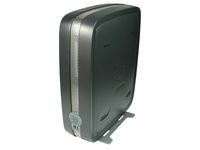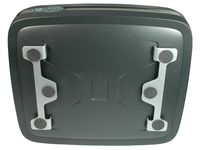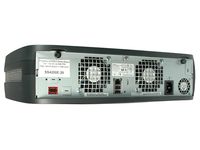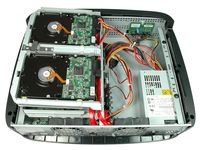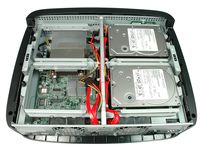Intel SS4200-E: PC-Based NAS Evaluated
Build, Technical Data, And Power Consumption
The Intel SS4200-E is available for just under $600 online; hard drives are not included in this price. You will be surprised as soon as the new Intel NAS device arrives: at almost 7 kg, the SS4200-E is a lot heavier than the network storage products from other manufacturers. The heavy weight can be explained by the fact that Intel protects the unit’s insides with a solid metal housing. Even the clamps for the hard drives, which competitors usually make out of plastic, are solid metal. The user can choose to put the housing in either a horizontal or vertical orientation, almost like a game console. Feet are included in the package for the latter option.
Metal Housing, Plastic Cover
For aesthetic reasons, Intel put a dark grey plastic cover over the metal housing. Another visual feature is the silver plastic stripe with small holes in it, which surrounds the front and the sides of the case.
The clean design is also apparent from the front of the housing, which only has one power button. This changes color from blue to amber depending on the status of the system. The same is true for the four LEDs that show the status of the hard drives. Another two LEDs inform you of hardware drives and network activity. Finally, there are two USB 2.0 ports on the front to let you connect external storage media.
Ports on the Backside
The back of the housing is organized similarly. The first thing you’ll notice are the two 70 mm fans that blow the warm air out of the unit. A third fan is responsible for exhausting air from the 250 watt power supply. Although there are three fans in total, you can hardly hear them during normal operation.
On the back of the Intel SS4200-E you will find another pair of USB 2.0 ports and two eSATA ports. Because the chipset is missing support for the eSATA ports, they are controlled by a Silicon Image SIL3132CNU controller. You connect to a network using a Gigabit Ethernet port managed by an Intel 82573E Ethernet controller.
Get Tom's Hardware's best news and in-depth reviews, straight to your inbox.
Power Consumption
You may have been a bit concerned by the aforementioned 250 watt power supply, and unfortunately, we have to confirm those worries. The Intel SS4200-E is not an energy-saving wonder. The NAS device uses a full 35 watts, even with a configuration of two hard drives put into sleep mode. When doing read and write operations with four hard drives, the power consumption used hovers around 70 watts. As expected, we measured the highest power consumption when turning on the device on: about 140 watts.
| Row 0 - Cell 0 | 2x HDD | 4x HDD |
| Sleep | 35 W | 38 W |
| Idle | 46 W | 60 W |
| Operating | 50 W | 73 W |
Hard Drive Mounting
In order to fit four hard drives into the housing, which measures only 12 cm, Intel’s engineers came up with an interesting design. The hard drives are placed next to each other in the housing and are mounted to it using screws with rubber heads. Not only can those screws be tightened without tools, but the rubber on them means that they also decouple the hard drives from the housing, effectively suppressing vibrations and reducing noise levels.
Current page: Build, Technical Data, And Power Consumption
Prev Page Intel And EMC Tackle NAS Next Page Installation and Software-
slomo4sho A HTPC type build is still the best low cost high performance option.Reply
Thanks for the write up :) -
gwolfman Very interesting. What if you replaced the horrible PSU with one of the picoPSUs made by minibox (if I'm not mistaken) or miniPSUs that are available. http://www.mini-box.com/picoPSU-120-power-kit?sc=8&category=981 OR http://www.mini-box.com/PW-200M-DC-DC-power-supply?sc=8&category=981 I have one of those running my mini-itx server and works flawlessly, cool, efficiently, and it's 100% silent!Reply -
malveaux Lol,Reply
$400, no drives, just the `chasis.'
It's a PC folks. Just build a cheaper PC with better components. It'll do more. And cost less.
What a joke, intel.
Cheesr, -
KITH malveaux, people might find added value in a nice, quiet, compact case that has easy setup and a warranty as well as customer support.Reply
spending time on purchasing, assembling, and configuring a custom device might not be an option or a at least not a better option. -
malveaux Kith,Reply
I understand that. Some people would rather have a box that hums and plugs in and just `works.' They won't want nor need to know how or why it works. They won't be able to troubleshoot it hardware-wise themselves, nor know a damn thing about it. They are still required however to plug in their own hard drives and configure the RAID if they wish it. There are markgets for NAS. But it's getting to be silly how many home-target NAS are being pushed out there that cost a ridiculous amount of money for what is essentially a computer that needs HDD's. For that cost, you might as well build your own computer. Or just take any old computer, but gigabit lan in it, fill with HDD's and run FreeNas. All problems solved on the cheap.
Support? Laughable. You'll talk to someone in Duabi or New Dheli or whereever, they'll tell you to unplug it, reset your router, plug it back in, push the power button and wait for it to re-connect. They can't help you with HARD DRIVE problems which is the SOLE purpose of the thing--to serve from HDD's.
I'm all for an attractive easy headless case with built in parts for HDD's. But for $400 and higher for this thing? Please. Any fool reading this website can NewEgg the parts needed, child's play, and have a NICE looking little microatx box housing the SAME capacity and function for less money. The issue with that? Requires a little elbow greace to assemble? Are these the same people who can't change their own tire? ... Probably. There went my whole argument. -
very very very IMPORTANT!!!!!Reply
already build an ss4200-ee with 4x1TB hdd, but it went down after 2 weeks.after changing the hardware the data was not recoverd cause the firmware of the ss4200-ee is not similar in another same ss4200-ee
now i have to wait 1 month for the nas to come back from egypt where intel repairs those nas in the middel east
for those who r intrested into building a nas, think of software raid not hardware.
-
I really don't understand any of these NAS devices. I have an dual core socket 939 motherboard with 3 4-disk RAID 5 arrays (Linux software RAID) and a bunch of single disks, and I can get 40 MB/sec from the single disks over my gigabit network, and faster from the RAIDs. I have the drives in a bunch of Silverstone CFP51 4-drive bays.Reply
Total cost for a cheap case, 4 of the CFP51s, PCI and PCIe controllers, motherboard, CPU and 4 GBs of RAM is probably $7-800, ready to hold 16 hard drives, and considerably faster. -
malveaux claude,Reply
Exactly my point. Since that machine has EVERY piece of hardware SOLDERED to it, you can't just replace ONE part if it breaks. You replace the WHOLE thing. And that's NOt including your HDD's, which they don't help you with, that's just the chasis and the board that has the SOLDERED OS in place, with ZERO input points for changing that.
Support is not possible with a unit like this. Meaningful support, that is. Support that is, "oh sorry to hear that, want to ship it over sears to me? $200 dolla? OOps! It no work, buy new one. BAI!" -
Taracta The real issue with this device is the SIZE! For just holding four (4) drives it is HUGE! Properly built this case could hold 2 to 3 times (8 - 12)as much drives.Reply
You can also get this product without an OS (EMC software) and use Home Server as the OS.
